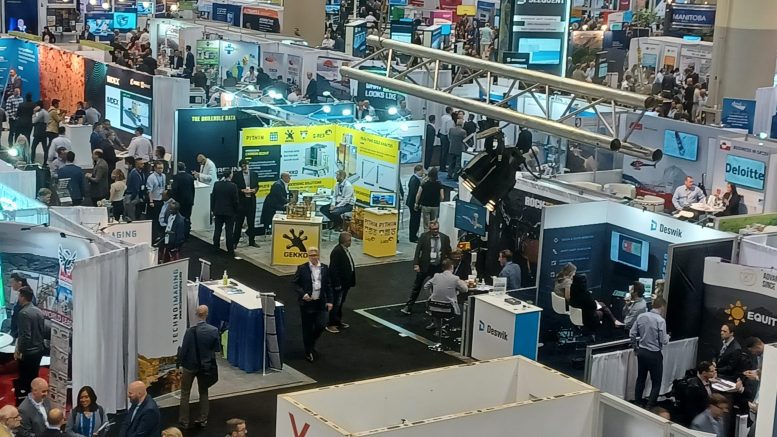A few things were top of mind for delegates as they converged on the Metro Toronto Convention Centre June 13-15 for the first in-person Prospectors and Developers Association of Canada (PDAC) convention in more than two years. Excitement about meeting in person again; mild shock at how pleasant a city Toronto can be outside of early March, when the convention is normally scheduled; and despite the market turmoil that coincided with the show, optimism about the need for mined metals in a world that’s desperately trying to wean itself off fossil fuels.
One thing that didn’t appear to be on the minds of many, however, was the risk of actually catching Covid-19 — the whole reason for the long delay between in-person PDAC shows.
PDAC was preceded by other mining shows that restarted this year — including the AME Roundup and the Vancouver Resource Investment Conference in B.C., and Mining Indaba in South Africa — but it was the largest such show, attracting more than 17,500 people in the flesh. That’s down from the March 2020 conference numbers of 23,000, and the upwards of 25,000 who attended in each of 2019 and 2018.
Although there were signs greeting delegates at the entrance that expressly “requested” attendees wear masks, few actually did — maybe around 10% at best.
And a huge bottleneck on the first day of the show caused a lineup of more than an hour and crowding of hundreds of people Monday morning as preregistered delegates waited to get their passes printed.
Minimal masking was a bit curious for a safety-obsessed industry that navigated the first year of the pandemic admirably, putting in place strong safety protocols and in many cases, donated PPE to local hospitals experiencing severe shortages in those early days.
Maybe it would be unreasonable to assume a higher rate of masking, however, considering that even physicians seem to shed their masks en masse at conferences. A medical conference in New Orleans in May organized by the Society for Academic Emergency Medicine (SAEM), hosted a more modest 3,000 delegates — still one of the SAEM’s largest events, according to a June column in StatNews.com. However, the column’s authors, who attempted to track the degree of Covid-19 spread from the conference (a difficult task in the absence of any official attempt to track cases), noted a similar environment to PDAC. “Social media images from conference events showed large, closely packed indoor crowds in close contact and without masks on,” the columnists wrote.
It will be interesting to see if the 91st annual edition of the PDAC conference, which will be back to its usual slot in March in the midst of the Northern Hemisphere’s cold and flu season, will see as casual an approach to Covid-19 precautions. Full disclosure, I did test positive several days after I attended the show — and I will be one of the masked 10% at the next industry event.
Not just needed, but wanted
Aside from the desire to put the pandemic behind us, mining’s role in the energy transition was a strong focus at the convention. At a panel on what decarbonization means for the junior mining sector, there was a sense of frustration, however, that the industry isn’t getting more traction despite the clear need for metals in a net zero future.
Rohitesh Dhawan, president and CEO of London-based International Council on Mining and Metals (ICMM) summarized the issue nicely. “For us to be relevant, we have to be the leaders in decarbonization ourselves. If we’re saying to the world, our metals are absolutely critical to decarbonization — which they absolutely are… ultimately, that comes with a responsibility to make sure that the way those metals are introduced (is done in as responsible a way as possible),” Dhawan said.
“If we show that we can produce these metals cleanly and in ways that promote social development, not only will people see us as needed… but our sector will be wanted, and that’s the place that we need to get to.”
To that end, the ICMM is working on clear, consistent reporting guidelines that miners across different commodities can measure, report, and set targets for when it comes to Scope 3 emissions. Dhawan says the organization expects to release the guidelines by the end of the year.
Indigenous inclusion
With so many resource projects being located on Indigenous lands globally, another theme was the ongoing renegotiation of the relationship between miners and Indigenous communities, who are exercising their rights and expecting more from mining companies. That includes equity stakes in projects or companies over employment and other benefits that traditional impact benefits agreements (IBAs) spell out, as well as more authority in permitting processes, and exploring ways to improve communities’ access to capital.
I was privileged to moderate a discussion on increasing Indigenous representation on corporate boards that included Canadian Indigenous leaders Fiona Blondin, Shannin Metatawabin, Martha Manuel and Matthew Coon Come. Coon Come, a Cree activist and former National Chief of the Assembly of First Nations and Grand Chief of the Grand Council of the Crees, and former Newmont board member, advised: “Never underestimate your knowledge as an Indigenous person.” While intended for Indigenous members of the audience, those are also wise words for mining companies, which currently have very few Indigenous board members, but would benefit from Indigenous perspectives in their leadership as they begin to navigate new relationships with Indigenous communities.


Be the first to comment on "PDAC showed industry eager to return to ‘normal’"